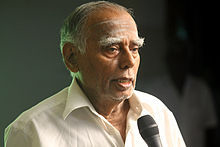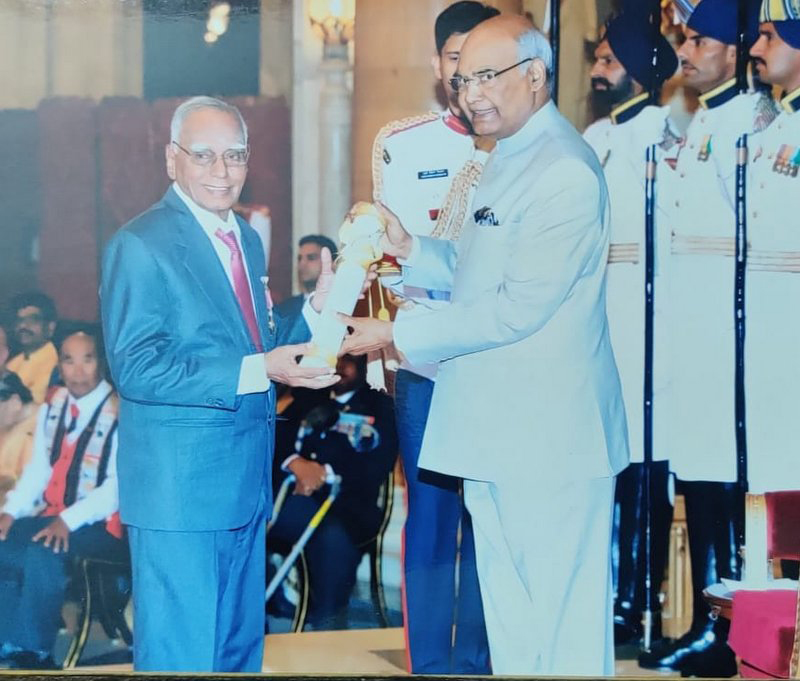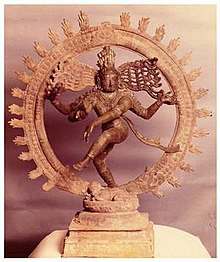Registered with the Registrar of Newspapers for India under R.N.I 53640/91
Vol XXXI No. 20, February 1-15, 2022
When Nagaswamy retrieved Nataraja
by K.R.A. Narasiah
Dr. R. Nagaswamy, the eminent archaeologist passed away last week at the age of 92. This tribute to him has been penned by KRA Narasiah.
Dr. R. Nagaswamy, the Padma Bhushan recipient for his contribution to the department of Archeology in general and for his professional competence in retrieving the Pathur Nataraja idol from the UK in particular, was born on August 10, 1930. After obtaining his master’s degree from Madras University in Sanskrit, (his father Ramachandran Sastrigal was a scholar in Sanskrit) Nagaswamy pursued his doctoral studies in Pune and obtained a doctorate from the Poona University in arts and archaeology, after which he went through a training programme under the Archaeological Survey of India.

In 1959 he joined the Government Museum Chennai as its curator for art and archaeology. There he studied Chola bronzes in depth and later joined the department of archeology of the Government of Tamil Nadu as assistant special officer for two years before becoming the first Director of the department in 1966 which post he held till his retirement in 1988. This State department was started in 1961, with the objectives of conservation and preservation of ancient monuments in Tamil Nadu in addition to conducting excavations at historical sites. Later its activities expanded to include epigraphy (copying and deciphering stone inscriptions, printing and publishing them for the public), setting up of site museums, chemical preservation of art objects, registration of antiquities, etc.
 Dr. Nagaswamy receivieng the Padma Bhushan from President Ram Nath Kovind.
Dr. Nagaswamy receivieng the Padma Bhushan from President Ram Nath Kovind.Dr. Nagaswamy had many feathers to his cap; his contribution to Tamil society in general and to Tamil Nadu in particular is highly commendable. But in my view, his most outstanding contribution was the retrieval of the Pathur Nataraja idol from the UK.
It all started when Pathur a sleepy nondescript little village tucked away in Nannilam Taluk of Thanjavur district of Tamil Nadu became prominent for all the wrong reasons. In 1976, Ramamurthy, a village farmer of Pathur, while digging the field of Sri Viswanatha Swamy temple struck upon some bronze icons. Thinking that he may be able to get some money for them and little realizing that he was going against the Treasure Trove Act 1878, he made enquiries. He did not know the real value of the idols anyway. Mujbul Hussain, a Beedi merchant of Tiruchi who got wind of the matter and who realized the the idols’ value, offered Ramamurthy Rs 200/- for the Nataraja, with a promise of more later for the others. After getting it from Ramamurthy he sold the Nataraja to a Paul Nadar, a middleman, for Rs. 1,500. The Nataraja was then transported to a regular receiver in Mumbai for Rs. 30,000/-. It was packed and sent in a lorry, the consignment being labeled household utensils.
 The Pathur Nataraja.
The Pathur Nataraja.The subsequent passage of the bronze from India to London and its purchase by Robert Borden, the Chairman of Canada-based Bumper Development Corporation, for a whopping sum of Rs.57.5 lakhs showed the network’s efficiency. When the bronze needed to be cleaned it was handed over privately to an employee of the British Museum. The Scotland Yard chanced upon this idol and on questioning the lady entrusted with cleaning, understood the background and promptly took possession of the idol, lodging a complaint with the London special court, and proceeded to get information from the Indian Government. In the meantime, Julian Sherrier, an art dealer falsely claimed that the bronze was in his possession for some years to show that it did not come from India recently.
With the help of the Tamil Nadu government, the Indian Government alleged that the idol was stolen from Viswanatha Swamy temple in Pathur. Investigation by Tamil Nadu CID under IGP Sri Rajasekharan Nair revealed that the idol was indeed unearthed from the field belonging to the temple. Nair started investigations and found that the idol was buried in historic times close to the temple along with others to protect them from invaders. To prove the idol belonged to Pathur, a petition was filed by Sivakami, the idol consort of Nataraja, and Indian envoy in the UK, P.C. Alexander represented Sivakami in the court. P. Chandrasekhran, a forensic expert provided assistance.
The Indian Government took a serious view and knew that such idols of Nataraja are prized objects being the finest specimens and belong to the Chola period of the 11th century and left no stones unturned for its retrieval. The case was fought by the Queen’s counsel Adrian Hamilton assisted by the London-based Indian barrister Baskar Ghorpade.
Ramamuthy who found the idol, the beedi merchant Maqbool Hussein, and Paul Nadar the dealer were all taken to London and a special translator was employed. The Government retained the forensic expert P. Chandrasekharan and more importantly R. Nagaswamy who proved vital during the trial. The case set a record in the UK – by taking just 44 working days. Hamilton and Ghorpade’s arguments evoked much legal curiosity. They maintained that “once a deity, always a deity. An idol remains a juristic person however long buried or damaged, since the deity and its juristic entity survive the total destruction of its earthly form.” They argued that the temple’s rights were not affected by the mere fact of the idol’s clandestine removal and export.
If the arguments sounded offbeat, Justice Kennedy’s judgement was fascinating. He said he was entirely “persuaded” that the London Nataraja was the Pathur Nataraja. The judge concluded: “A juristic entity, which has a title to the Nataraja, is superior to that of the defendant.” The judge praised Nagaswamy for his quoting from Agama Sastra on methods to be adopted while burying idols in case of danger from other sources, which proved with no doubt that the idol was indeed buried for safe keeping as per Agama sastra. When an appeal was made against the judgement by the procurer it was dismissed with costs.
During his time as the Director, it was also an aim of the department, to showcase the rich language of Tamil in its classical form, and its magnificent monuments. Thus the department soon became a centre for research and dissemination of knowledge. Starting with his quest for protection of historical monuments and inscriptions, Nagaswamy first took interest in the Irumporai inscriptions at Pugalur near Karur (Chera) of the first century. Similarly, his noteworthy works were connected with Gangaikonda Cholapuram, Thirumalai Nayak Mahal at Madurai and the Danish fort at Tharangambadi.
One of his pet projects was to make archaeology a popular subject in Tamilnadu, especially among students. Under this scheme he was responsible for involving several thousand school and college students in cleaning and preserving historical places and monuments, situated close to their institutions. To make this project a success he used to take around 40 teachers across the state annually to various monuments and explain to them their historicity. His focus was to emphasize on history and not associate with myths. And to popularize the monuments he brought out guides in the form of information bulletins, low priced so that all could afford to buy and read.
He piloted the first ever Son et lumiere (sound and light show) programme in the Thirumalai Nayakar Mahal in Madurai as early as in 1982. It was also to his credit that he conducted an underwater archaeological survey in the Coromandel coast line from Poompuhar to Nagappattinam in collaboration with Oceanographic Survey of India. Another major breakthrough he brought in was conducting the Chidambaram dance festival. He says it was a regular ritual for dancers to perform in temples till the 19th century, though during colonial rule dancers were treated rather poorly and looked down upon. Wanting to change this attitude and bring dance to its respected form he introduced this festival in Chidambaram which continues till date, growing with each year.
When he took over as Director, fresh sites were excavated under his guidance which included Panchalam Kurichi – where the remains of Veera Pandya Kattabomman’s palace were unearthed. He also worked on Korkai, the 2,000 year-old port town of the Pandyas where the Tamiraparni empties itself into the sea, and more importantly Karur, the capital of Sangam age Chera kings. At the Karur site pottery shards, amphorae and old coins were found that stand testimony to the glorious sea trade of the Sangam age.
Nagaswamy states in his often referred book, Roman Karur, that this town in Tiruchi district has been a real mine in terms of the astonishing number of antiquities found, especially coins, and inscribed objects both in quantity and variety. Tamil scholar Francois Gros of the Ecole Francais Extreme Orient, Pondicherry, suggested that Nagaswamy should undertake deeper study about Karur findings. (Earlier the director of South Indian Philology and History at the Ecole Pratique des Haute Études at the Sorbonne in Paris, Gros declared that the most satisfying time of his life was the 14 years he spent in Pondicherry between 1963 and 1977). This suggestion, it appears, made Nagaswamy write the book Roman Karur. It was becoming increasingly clear to Nagaswamy that the Roman presence in Tamil Nadu had left a far deeper impact on the economy, defence, arts and architecture than what was usually given credit for .
In his book Nagaswamy states that Karur was undoubtedly the capital of the Cheras of the Sangam age as some of the coins bear the names of the Chera rulers whose names are found in the Sangam classics. The names that could be seen in Sangam literature on an impressive scale are of the period after the establishment of Roman trade. “One thing seems to be clear that beginning from the royalty and the rich merchants, the quality of life of the people seems to have been enriched by the Roman contact and therefore Karur, Vellalur and Thirukkoilur finds of Roman gold coins and jewellery are of great significance to this study”, he says and continues “Sri Iravatham Mahadevan has been my close friend and a source of inspiration in the field of Tamil Brahmi script studies. When the outstanding gold signet ring from Karur was found Mahadevan gave the photograph to me and encouraged me to write on its significance, instead of him writing on it.”
This gesture said Nagaswamy reminded him of the Sangam chieftain Atiyaman who gifted the fruit of immortality he obtained to the poetess Avvaiyar, instead of himself benefitting from it. Nagaswamy also gained by the association of Dr. R. Krishnamurthy, Editor Dinamalar a world-renowned numismatist, who identified the Chera coins during this project.
Nagaswamy’s death is a great loss to Indian Archaeology in general and Tamil Nadu in particular.

